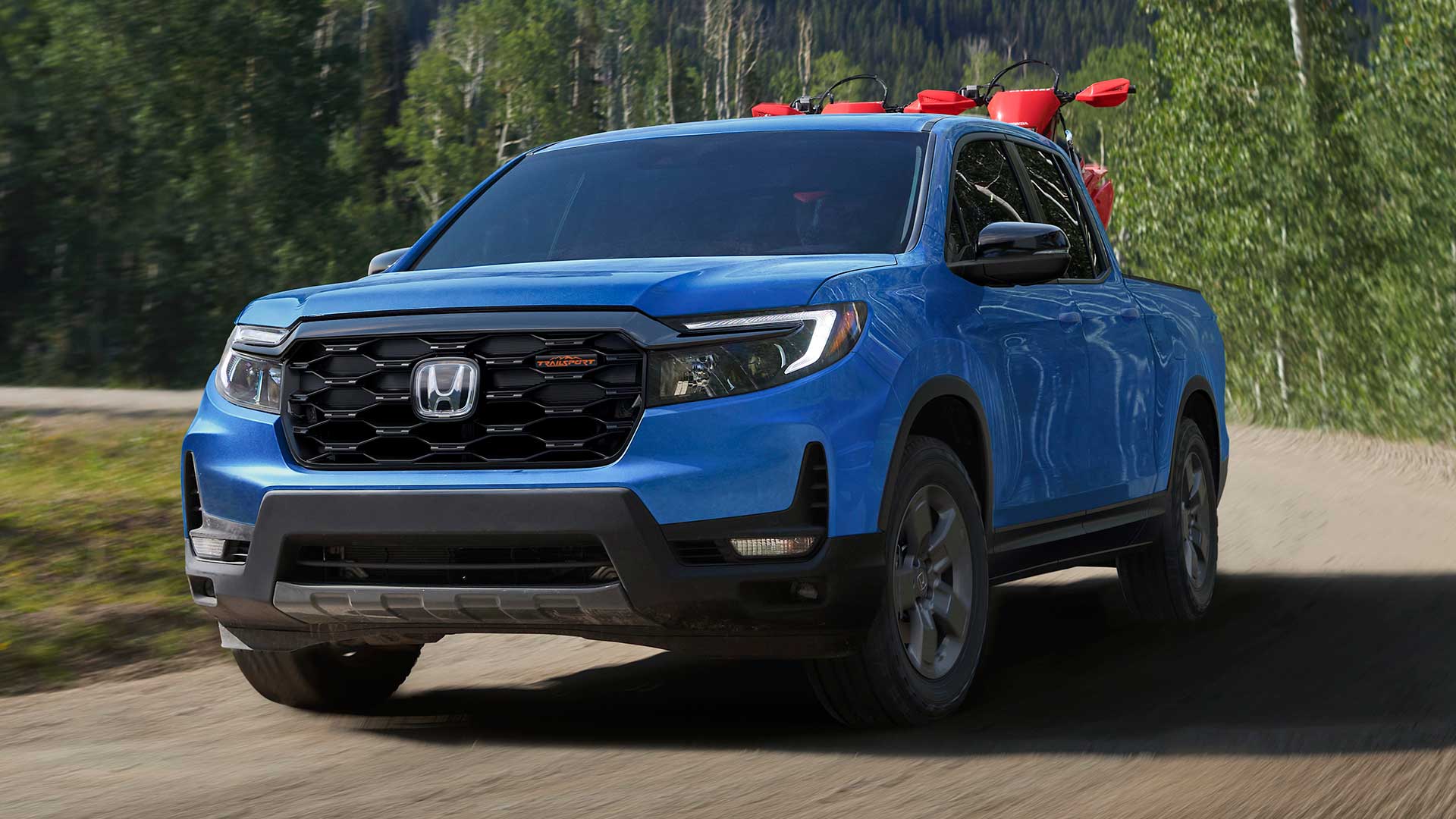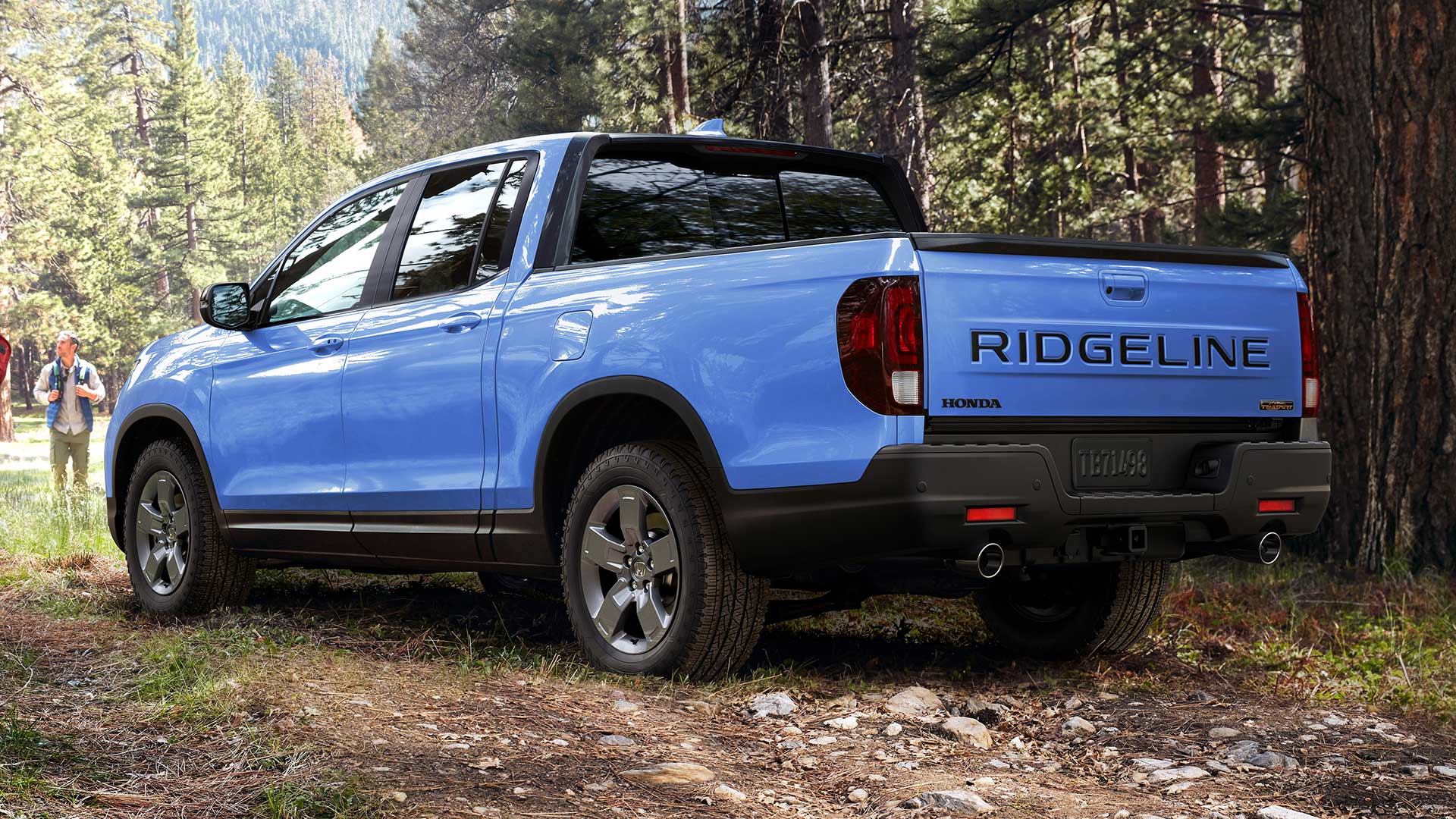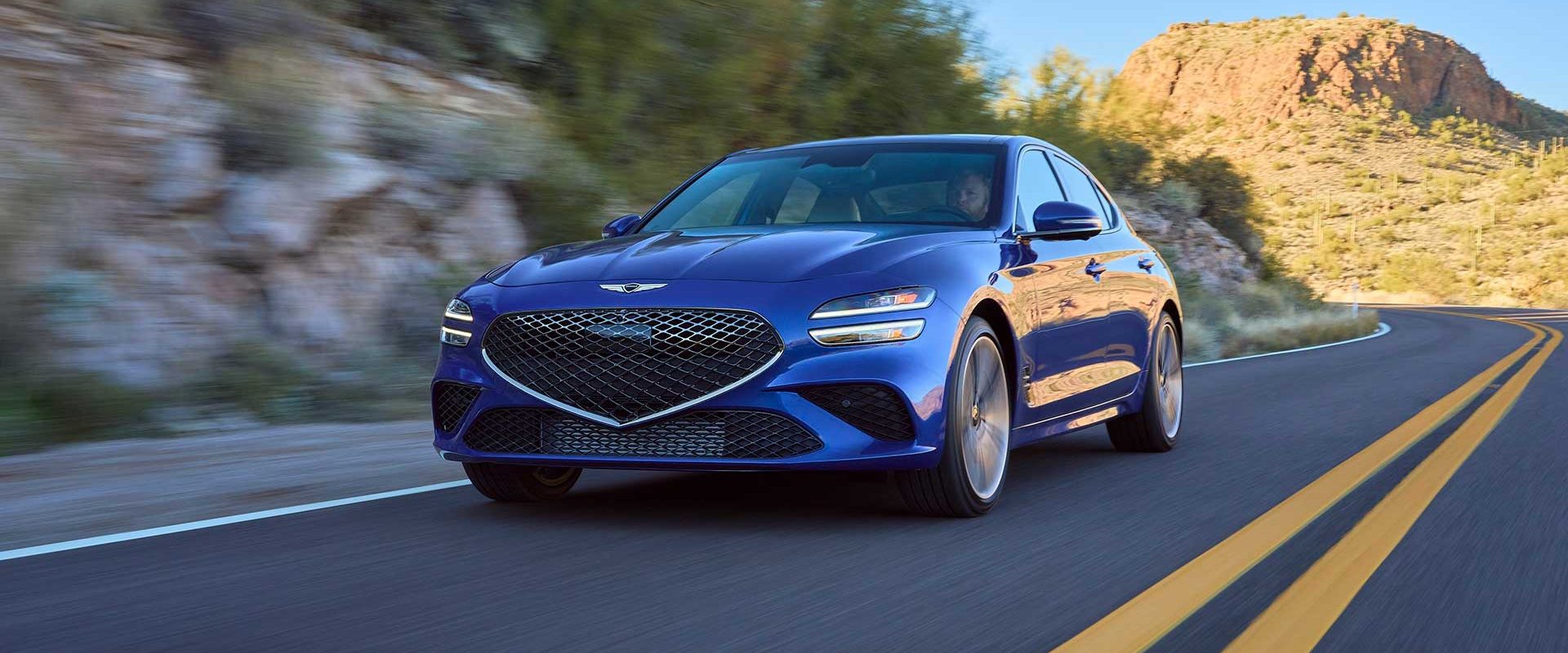2012 Fiat 500 Abarth
We’ve spent quite a bit of time in the tiny little Fiat 500, both in coupe and convertible form. And have found that if you can handle the ultra-cute looks, the 500 offers a ton of fun for the money. Well, if you’re looking for even more fun for not a lot more money, this Fiat 500 Abarth may just be the ticket. So let’s punch it and find out!
Here at MotorWeek, we’re all about getting the best performance bang for our buck, and the 2012 Fiat 500 Abarth embodies that sentiment in spades. For starters, this “small, but wicked” Fiat gets a huge boost in power. Under the hood is a thoroughly beefed up version of the MultiAir 1.4-liter I4 found in the standard 500. But, here turbo boost output by 59 horsepower to 160; that’s 114 ponies per liter! Even more impressive, torque nearly doubles to 170 pound feet.
The Abarth name may be new to most, but the company has a 60 year tradition of pumping performance out of Italian ride. Now as Fiat’s inhouse tuner, Abarth has done a lot more than just slap on a turbo and call it a day. The 500 Abarth is a total transformation. The suspension has been thoroughly tweaked with new Koni Frequency Selective Damping shocks, stiffer springs, and a solid rear stabilizer bar and all told, sits half an inch lower.
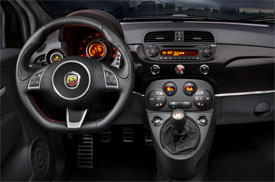 Just punch the Sport button for maximum engine output, quicker throttle response, and more steering feel, and you’re ready to blast through the corners. Under-steer has been almost eliminated, turn-in is insanely quick, and the car flat out sticks. More fun? Definitely! Faster? Well, let’s see. Fast is always a relative term, and 0-60 time of 7.7-seconds is not exactly supercar territory, but it is certainly much quicker than previous 500’s that we’ve tested, almost 2-seconds faster, actually.
Just punch the Sport button for maximum engine output, quicker throttle response, and more steering feel, and you’re ready to blast through the corners. Under-steer has been almost eliminated, turn-in is insanely quick, and the car flat out sticks. More fun? Definitely! Faster? Well, let’s see. Fast is always a relative term, and 0-60 time of 7.7-seconds is not exactly supercar territory, but it is certainly much quicker than previous 500’s that we’ve tested, almost 2-seconds faster, actually.
The quarter mile is obviously quicker as well, at 15.8-seconds and 89 miles per hour. Off the line, the Abarth puts the power down fairly effectively with no torque steer. First and second gears pass quickly, but third is a real workhorse, taking you through most of the ¼ mille. A Ferrari it’s not, but somehow it’s almost just as thrilling. And the sound is great, even if it’s not from a V-12.
Transmission is 5-speed manual only. It needs a 6th gear! Still, the upgraded unit worked flawlessly throughout our testing. Stopping is also improved, bringing our Abarth to a halt 2-feet sooner than a 500 Sport at 120-feet from 60.
We all know that Italians like to do things with style, and the Abarth certainly gets a runway worthy makeover, but rest assured there’s function to go along with that form. Starting with a 500 Sport, the Abarth gets a more vertical front fascia, to make more room in the engine bay for turbo plumbing, and to allow room for larger air intakes. Down the sides are extended skirts, and on our test car, painted aluminum 17-inch wheels which replace the standard 16’s. In back, there’s a re-designed fascia, with black lower diffuser and double dual-tipped exhaust; and of course a big rear spoiler. And if all of that weren’t enough, there are Abarth scorpion shields on just about every body panel, though the red mirror caps and body side stripes are optional.
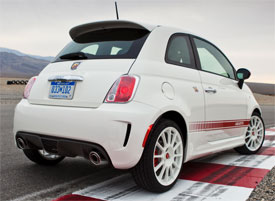 We already loved the purposeful interior design of this modern Cinquecento, and now there’s even more amore, with added Abarth elements like a nice thick flat-bottom steering wheel, black leather with red stitching on the gauge hood and shifter, aluminum pedal covers, and body hugging performance seats. Our car had the optional Rosso Nero leather. We’re still not fans of the concentric gauge array, or the dash top TomTom nav, but have no qualms at all about the new turbo boost gauge. While much more comfortable for two than four, the 500 remains surprisingly practical with its 9.5 cubic-feet of trunk space expanding to 26.8 with rear seats folded.
We already loved the purposeful interior design of this modern Cinquecento, and now there’s even more amore, with added Abarth elements like a nice thick flat-bottom steering wheel, black leather with red stitching on the gauge hood and shifter, aluminum pedal covers, and body hugging performance seats. Our car had the optional Rosso Nero leather. We’re still not fans of the concentric gauge array, or the dash top TomTom nav, but have no qualms at all about the new turbo boost gauge. While much more comfortable for two than four, the 500 remains surprisingly practical with its 9.5 cubic-feet of trunk space expanding to 26.8 with rear seats folded.
Government Fuel Economy Ratings are 28-City and 34-Highway; expect 31 miles-per-gallon of Premium in everyday driving. The Energy Impact Score is quite good at 10.6-barrels of oil consumed per year with annual CO2 emissions of 4.7-tons. As for pricing, the 2012 Fiat 500 Abarth retails for $22,700; that’s about 5-grand over a 500 Sport, but it’s money well spent, as you are definitely getting Filet performance on a PBJ budget which is exactly the way we like it here at MotorWeek. The Abarth is the most fun we’ve had in a car that costs under $25,000, in some time. So, buy two, they’re small!
Specifications
- Engine: MultiAir 1.4-liter I4
- Horsepower: 160
- Torque: 170 lb-ft.
- 0-60 mph: 7.7 seconds
- 1/4 mile: 15.8 seconds @ 89 mph
- EPA: 28 mpg city/ 34 mpg highway
- Energy Impact: 10.6 barrels oil/yr
- CO2 Emissions: 4.7 tons/yr
2024 Honda Ridgeline TrailSport
It Does Truck-Like Things Better Than Ever
Honda brought something truly unique to the pickup truck scene when their mid-size Ridgeline debuted for 2006. In 2017, it moved towards becoming a little more true truck-like, both in form and capability, now with yet another step in that direction for 2024. So, let’s see if the Ridgeline is really hitting its stride.
For 2024, it’s all about making this Honda Ridgeline better than ever. There are styling tweaks outside, along with tech and functional improvements inside, but the biggest news is the Ridgeline has now joined Honda’s TrailSport family of off-road inspired vehicles. This more-true-trucklike, second-gen Ridgeline been around since 2017, receiving periodic updates over the years; but joining the TrailSport family is the biggest leap yet.
Primarily, the TrailSport transformation includes General Grabber all-terrain tires, mounted on new Pewter Gray 18-inch wheels, steel underbody protection, and retuning the strut front, and multi-link rear suspension for added wheel articulation. And while we always appreciate the additional traction of off-road tires, the Ridgeline’s standard i-VTM4 all-wheel drive, with Intelligent Traction Management and snow, sand, and mud settings, was already quite capable of handling all but the most extreme off-roading, ground clearance of just 7.6 inches being it’s only real hinderance.
A 3.5-liter V6 remains under the hood as it has since the Ridgeline debuted for 2006; the current version outputs 280 horsepower and 262 lb-ft of torque, plenty enough muscle to handle its 5,000-lbs. towing capacity. A nine-speed automatic transmission with paddle shifters and bevy of push and pull buttons on the console replaced the six-speed automatic back in 2020.
In addition to adding TrailSport capability, a big focus for this update was making it more user-friendly inside, starting with the central touchscreen growing from 8 to 9 inches. It also gets faster processing speeds, menus have been simplified, and the native navigation system is improved with better graphics. It’s accompanied by a new digital instrument cluster, along with an upgraded center console with more storage space. Unique TrailSport touches include heavy duty floormats, leather-trimmed seats, orange stitching throughout the cabin, and orange ambient lighting.
The Ridgeline continues to offer things available nowhere else in the pickup truck market.
Exterior styling doesn’t exactly shout “macho big rig coming your way,” but the more vertical face and larger grille that arrived for 2021, along with this year’s added TrailSport elements, do continue to toughen up the Ridgeline’s image. The 5’4” bed remains highly functional with no large wheel well intrusions, multiple tie-downs points, lighting and even speakers. And of course, the Ridgeline continues to offer things available nowhere else in the pickup truck market, like the dual-action tailgate, and large, lockable, drainable, underbed storage. Not to mention being able to drive around in true car-like comfort, something we took full advantage of on our way to our Mason Dixon Dragway test track.
There was great grip off the line, with full power arriving smoothly but quickly, helping us to get to 60 in 7.0 seconds flat, a tenth quicker than the last Ridgeline we tested. That power delivery stayed fairly consistent the whole way down the track, barely interrupted by the nine-speed automatic’s smooth shifting. Our best quarter-mile run was 15.5 seconds at 90 mph.
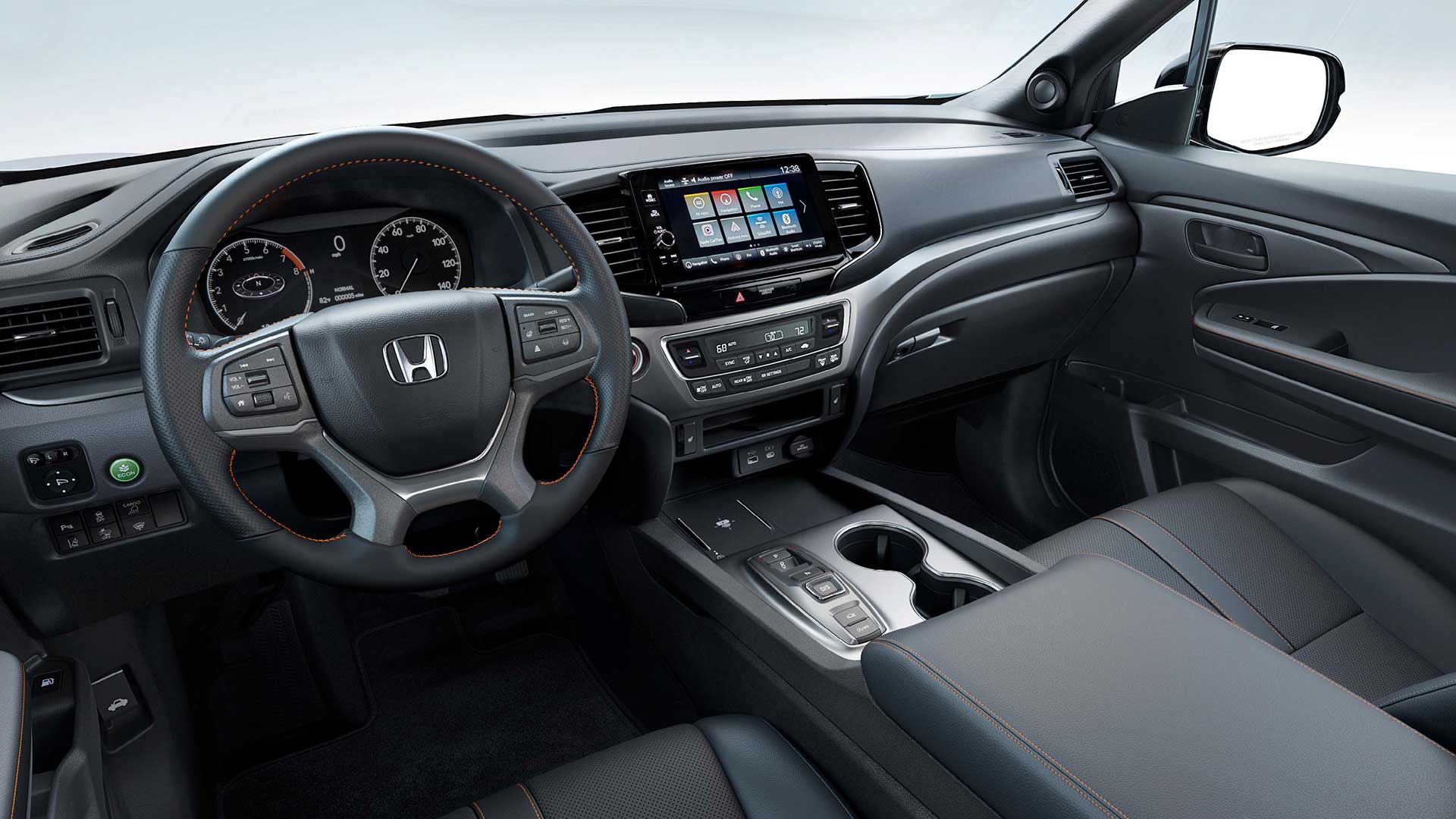
The revised suspension and knobbier tires didn’t really seem to add or detract from handling prowess, as it felt as solid, nimble, and car-like as it always has through our cone course. Perhaps a little less stiff than before, but good feedback, tight steering, and minimal body roll for a pickup, made for a very confidence inspiring experience. In our braking test, we stopped in a respectable average of 123 feet from 60, with only moderate amounts of nosedive and good feel through the pedal.
There is, however, a slight reduction in Government Fuel Economy Ratings with the all-terrain tires; 18-City, 23-Highway, and 20-Combined, our average, right on, at 20.4 mpg of Regular. That’s a slightly below average Energy Impact Score of 14.9 barrels of yearly oil use, with CO2 emissions of 7.4 tons.
TrailSport pricing falls in line just under the Ridgeline’s top Black Edition trim with a starting price of $46,375, about five grand over a base Ridgeline Sport.
So, whether you consider the Honda Ridgeline to be a “real” truck or not, this ruggedly smooth 2024 TrailSport does truck-like things better than ever. And we’re not just talking about the slight upgrade in off-road performance, we’re talking about a flexible bed to help you get chores done, and the ability to tow or haul with comfort and flexibility other trucks can only wish for. It’s why the Ridgeline brings more first-time buyers to Honda than any other vehicle, and why it continues to be a great choice in the growing midsize truck realm.
Specifications
- Engine: 3.5-liter V6
- Transmission: 9-speed automatic
- Horsepower: 280
- Torque: 262 lb-ft
- EPA: 18 City | 23 Highway | 20 Combined
- 0-60 mph: 7.0 seconds
- 1/4 Mile: 15.5 seconds at 90 mph
- 60-0 Braking (avg): 123 feet
- MW Fuel Economy: 20.4 mpg (Regular)
- Max Towing Capacity: 5,000-lbs
2024 Genesis G70
New Standard Engine For The G70 Means More Power And More Performance
It was 5 years ago, at a time when sedan sales were rapidly declining, that Genesis decided to unveil an all-new four-door, the G70. And just to make things more difficult, it was designed to compete directly against the best European compact sport sedans, which it did impressively well. So yes, the G70 is still hanging around; and what’s more, it’s gotten even better!
The Genesis G70 sedan has been on the road for half a decade now, and looks to have some real staying power, having outlasted its platform-mate, the Kia Stinger. But this 2024 Genesis G70 is not just surviving, but thriving, with a new standard powertrain, upgraded performance and an enhanced interior.
The standard engine in the G70 is now a 2.5-liter turbo I4 with 300 horsepower and 311 lb-ft of torque. That’s a 48-horsepower increase over last year’s 2.0-liter turbo-four. Genesis has also included a Brembo brake package as standard equipment. The 3.3-liter twin-turbo V6 remains available and carries over unchanged at 365 horsepower; both engines powering the rear wheels as standard, with all-wheel-drive optional.
The approach for the interior remains more of a sporty presentation instead of the outright luxury slant of larger Genesis sedans, and the main updates here include new touch-panel controls for climate and a frameless rear-view mirror. A reasonably priced Sport Prestige package adds leather seating, aluminum trim, a big sunroof and additional driver assistance features. Front seats are both sporty-feeling and comfortable, while things remain a little tight for adults in the rear seats.
No new sheet-metal for the outside, as that was freshened up for the ’22 model year; the design remains polished and smooth, void of garish details, but it does sport the new Genesis engraved emblem front and center above the grille.
Automatic shifts were very punchy, with a noticeable hit of power as each new gear was engaged.
We pointed that logo down our Mason Dixon Dragway test track to see what the new turbo-four engine is capable of. It felt plenty powerful off the line, even with a hint of turbo lag, and power delivery only became more aggressive from there. We hit 60 in 5.8 seconds, almost a half-second quicker than we saw with the 2.0-liter. That’s also with all-wheel-drive, which provided plenty of grip at takeoff, and good stability down the track, though spring track maintenance kept us from getting full quarter-mile times.
All G70s now work exclusively with a rev-matching eight-speed automatic with paddle shifters and intelligent drive modes; the six-speed manual transmission has gone away with the 2.0-liter. Automatic shifts were very punchy, with a noticeable hit of power as each new gear was engaged. Engine noise is pleasant but relatively muted, with just a hint of exhaust noise seeping into the cabin.
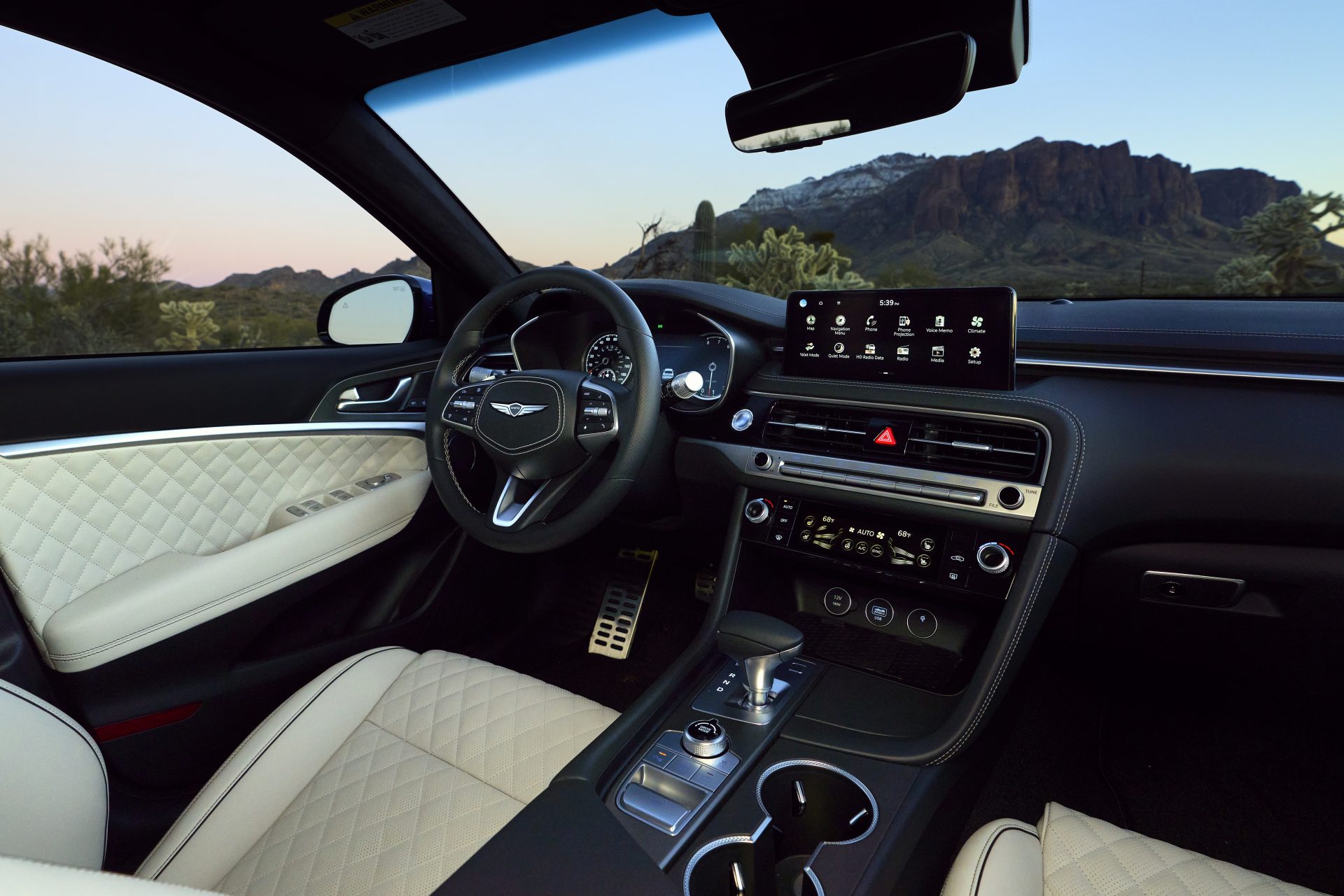
While the G70 can feel like a big sedan in everyday driving, here in our handling course, it felt tidy, nimble and quite comfortable working through the cones. We felt very connected to it, with great feedback through the chassis and steering wheel. Dynamic Torque Vectoring Control is in play to tighten up turn-ins and provide steadiness, and it worked great allowing us to be very aggressive without stability control systems stepping in, even when it began to show a little bit of understeer as we pushed the envelope.
As for everyday driving, Government Fuel Economy Ratings with the new four-cylinder and all-wheel-drive are 21-City, 29-Highway, and 24-Combined; we averaged a very good 27.8 mpg on Premium fuel. All for an average Energy Impact Score, using 12.4 barrels of oil annually with 6.2 tons of CO2 emissions.
The more powerful standard engine and interior upgrades add about two-grand to the G70’s new base price, which is now $42,750, $44,850 with all-wheel-drive; the twin-turbo V6 starts at $51,200.
These days, we’re just glad to see someone still making sporty 4-doors. So, when a brand puts the effort into making a good one even better, as Genesis has done with the 2024 G70, well that’s really a cause for celebration. The G70 may be a relative newcomer to the luxury sport sedan scene, but its comfort bang for the buck, along with its additional standard power and proven all-around performance, gives it the staying power it needs to succeed long term.
Specifications
As Tested
- Engine: 2.5-liter turbo I4
- Transmission: 8-speed auto
- Horsepower: 300
- Torque: 311 lb-ft
- EPA: 21 City | 29 Highway | 24 Combined
- 0-60 mph: 5.8 seconds
- 1/4 Mile: N/A
- 60-0 Braking: N/A
- MW Fuel Economy: 27.8 mpg (Premium)








